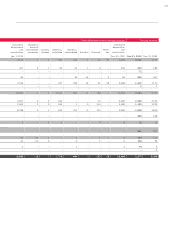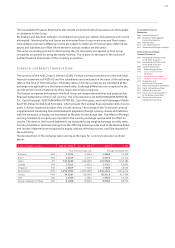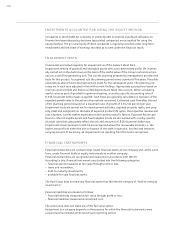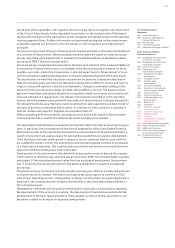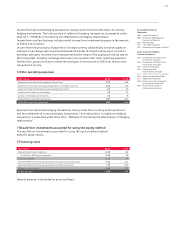Audi 2011 Annual Report Download - page 208
Download and view the complete annual report
Please find page 208 of the 2011 Audi annual report below. You can navigate through the pages in the report by either clicking on the pages listed below, or by using the keyword search tool below to find specific information within the annual report.
205
Consolidated Financial
Statements
188 Income Statement
189 Statement of Recognized
Income and Expense
190 Balance Sheet
191 Cash Flow Statement
192 Statement of Changes in Equity
Notes to the Consolidated
Financial Statements
194 Development of fixed assets
in the 2011 fiscal year
196 Development of fixed assets
in the 2010 fiscal year
198 General information
204 Recognition and
measurement principles
204 Recognition of income
and expenses
204 Intangible assets
205 Property, plant
and equipment
205 Investment property
206 Investments accounted for
using the equity method
206 Impairment tests
206 Financial instruments
209 Other receivables and
financial assets
209 Deferred tax
209 Inventories
210 Securities, cash and
cash equivalents
210 Provisions for pensions
210 Other provisions
210 Liabilities
210 Management’s estimates
and assessments
212 Notes to the Income Statement
218 Notes to the Balance Sheet
227 Additional disclosures
248 Events occurring subsequent
to the balance sheet date
249 Statement of Interests
held by the Audi Group
PROPERTY, PLANT AND EQUIPMENT
Property, plant and equipment are measured at acquisition cost or cost of construction, with
scheduled straight-line depreciation applied pro rata temporis over the expected useful life.
The costs of purchase include the purchase price, ancillary costs and cost reductions. Investment
subsidies are as a general rule deducted from the acquisition cost or cost of construction.
In the case of self-constructed fixed assets, the cost of construction includes both the directly
attributable cost of materials and cost of labor as well as indirect materials and indirect labor,
which must be capitalized, together with pro rata depreciation. No interest was capitalized in
relation to borrowing costs due to the fact that there were no significant borrowings as defined
in the criteria of IAS 23 given that the Audi Group maintains sufficient levels of net liquidity at
all times. The depreciation plan is generally based on the following useful lives, which are re-
assessed yearly:
Useful life
Buildings 14–50 years
Land improvements 10–33 years
Plant and machinery 6–12 years
Plant and office equipment including special tools 3–15 years
In accordance with IAS 17, property, plant and equipment used on the basis of lease agreements
is capitalized in the Balance Sheet if the conditions of a finance lease are met (in other words, if
the significant risks and opportunities which result from its use have passed to the lessee). Capi-
talization is performed at the time of the agreement, at the lower of fair value or present value
of the minimum lease payments. The straight-line depreciation method is based on the shorter
of economic life or term of lease contract. The payment obligations resulting from the future
lease installments are recognized as a liability at the present value of the leasing installments.
Where Group companies have entered into operating leases as the lessee, in other words if not
all risks and opportunities associated with title have passed to them, leasing installments and
rents are expensed directly in the Income Statement.
INVESTMENT PROPERTY
Investment property comprises real estate held as a financial investment and vehicles leased as
part of operating lease agreements with a contractual term of more than one year.
Real estate held as investment property is reported in the Balance Sheet at amortized cost.
Buildings are depreciated on a straight-line basis over a useful life of 33 years.
Leased vehicles, in the case of operating lease agreements, are capitalized at cost of sales and
depreciated to the calculated residual value on a straight-line basis over the contractual term.
Unscheduled reductions for impairment and adjustments to depreciation rates are made to take
account of impairment losses calculated on the basis of impairment testing pursuant to IAS 36.
Based on local factors and historical values from used car marketing, updated internal and ex-
ternal information on residual value developments is incorporated into the residual value fore-
casts on an ongoing basis.




